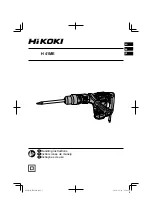
GB
- 20 -
5.6 Line guide (Fig. 7-9/Item 6)
Using the line guide (6) you can carry out exact
cuts following cutting lines marked on the work-
piece. Fit the line guide by mounting it on the top
of the soleplate (7) and letting it lock in place at
the bottom, as shown in Fig. 7. Use the mark (a)
for the 0° angle setting (Fig. 8) and the mark (b)
for the 45° angle setting (Fig. 9). See point 5.4 for
information about the angle setting.
Important! Carry out a trial cuts in a piece of
waste wood.
5.7 Splinter guard (Fig. 10/Item 17)
The splinter guard ensures that the material you
want to cut does not splinter or crack during sa-
wing. Insert it into the soleplate from underneath
as shown in Fig. 10.
Fit the splinter guard, as shown in Fig. 10, into
the soleplate (Point 1). Then squeeze the splinter
guard together at the back and latch it in the sole-
plate to secure it (Point 2).
Note!
The splinter guard can be used only for 0°
cuts and must be removed for miter cuts up to
47°!
5.8 Charging the Li battery pack (Fig. 11-12)
1. Remove the battery pack (d) from the handle,
pressing the pushlock button (c) downwards
to do so.
2. Check that your mains voltage is the same as
that marked on the rating plate of the battery
charger. Insert the power plug of the charger
(e) into the mains socket outlet. The green
LED will then begin to
fl
ash.
3. Push the battery pack onto the battery char-
ger.
In section 10 (Charger indicator) you will
fi
nd a
table with an explanation of the LED indicator on
the charger.
If the battery pack fails to charge, check for the
following:
•
voltage at the power socket
•
whether there is good contact at the charging
contacts of the charging unit
If the battery pack still fails to charge, send
•
the charger and charging adapter
•
and the battery pack
to our customer service center.
To ensure that items are properly packaged
and delivered when you send them to us,
please contact our customer service or the
point of sale at which the equipment was
purchased.
When shipping or disposing of batteries and
cordless tools, always ensure that they are
packed individually in plastic bags to prevent
short circuits and
fi
res.
To ensure that the battery pack provides long ser-
vice, you should take care to recharge it promptly.
You must recharge the battery pack when you
notice that the performance of the device drops.
Never allow the battery pack to become fully di-
scharged. This will cause it to develop a defect.
5.9 Battery capacity indicator (Fig. 11 /Item f)
Press the button for the battery capacity indicator
(g). The battery capacity indicator (f) shows
the charge status of the battery using 3 LEDs.
All 3 LEDs are lit:
The battery is fully charged.
2 or 1 LED(s) are lit:
The battery has an adequate remaining charge.
1 LED blinks:
The battery is empty, recharge the battery.
All LEDs blink:
The battery temperature is too low. Remove the
battery from the equipment, keep it at room tem-
perature for one day. If the fault reoccurs, this me-
ans that the rechargeable battery has undergone
exhaustive discharge and is defective. Remove
the battery from the equipment. Never use or
charge a defective battery.
6. Operation
6.1 On/O
ff
switch (Fig. 13/Item 3)
Switching on:
Press the locking button for the On/O
ff
switch (2)
fi
rst and then press the On/O
ff
switch (3).
In
fi
nitely variable stroke speed control is possible
with the On/O
ff
switch (3). The further you push
the switch, the higher the stroke speed.
Anl_TE_JS_18_80_Li_SPK13.indb 20
Anl_TE_JS_18_80_Li_SPK13.indb 20
19.08.2021 09:56:55
19.08.2021 09:56:55
















































